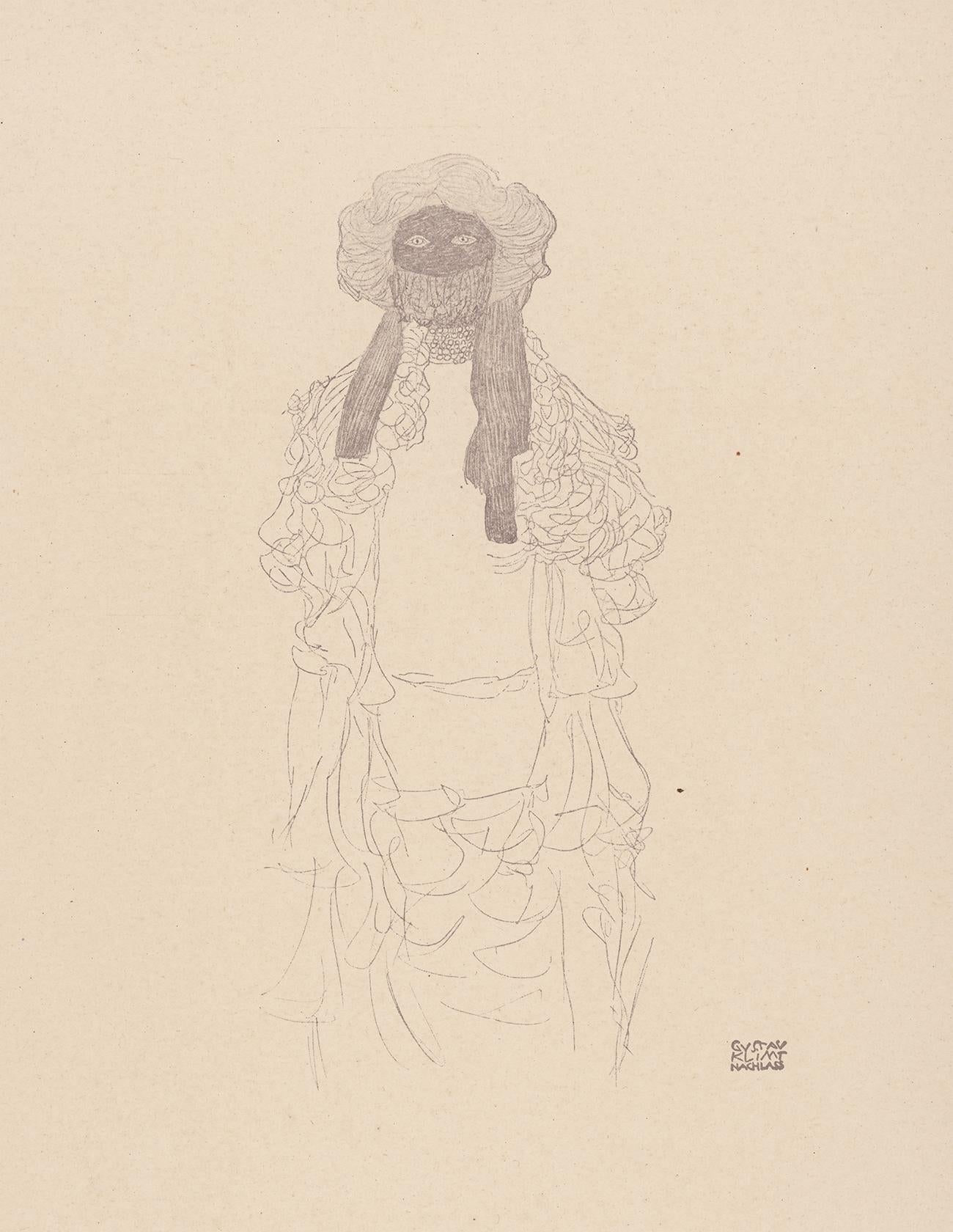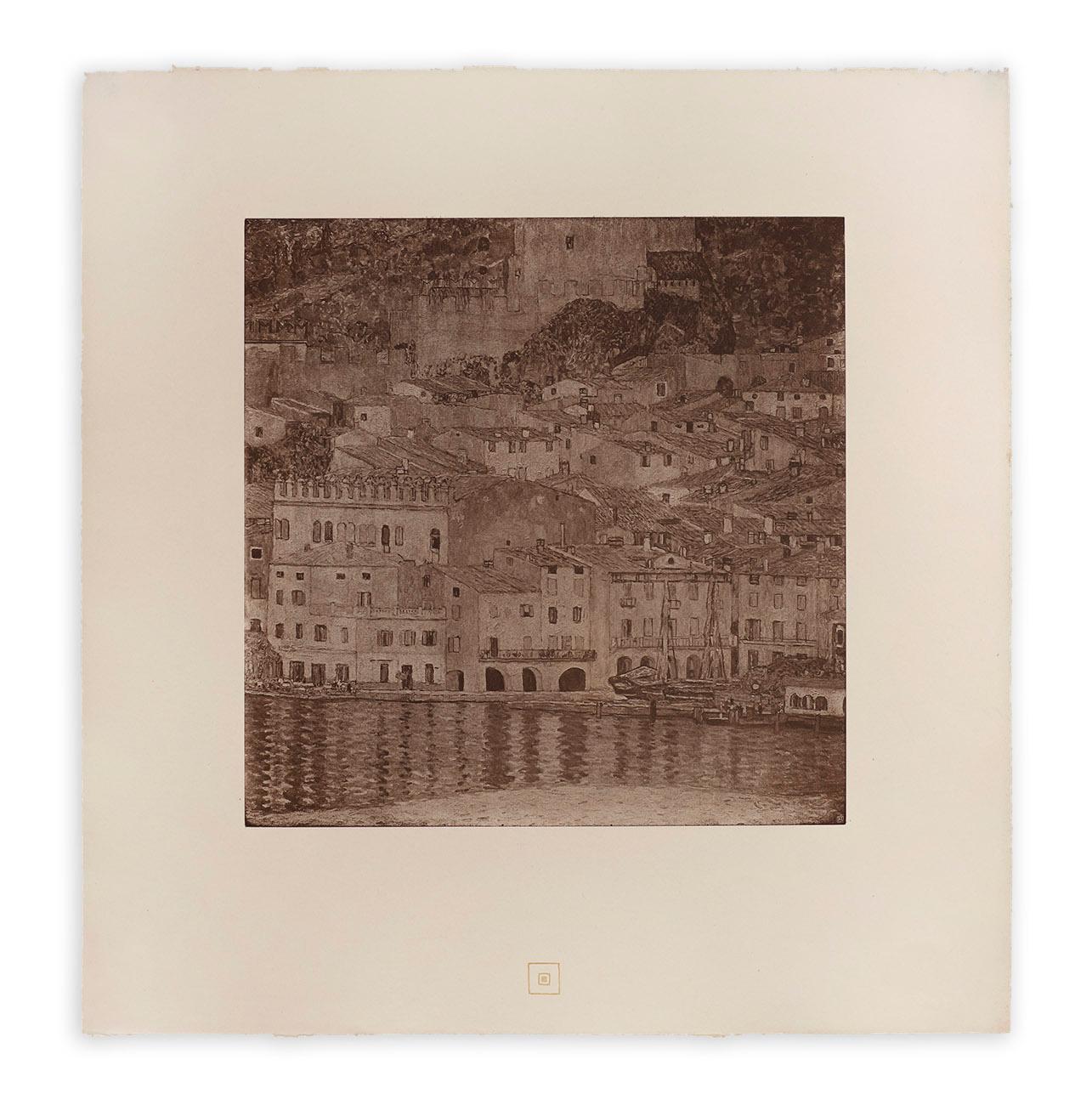Items Similar to Portrait of Friederike Maria Beer, Gustav Klimt An Aftermath collotype, 1931
Want more images or videos?
Request additional images or videos from the seller
1 of 6
Portrait of Friederike Maria Beer, Gustav Klimt An Aftermath collotype, 19311931
1931
About the Item
Original 1931 collotype created from Gustav Kilmt’s Portrait of Friederike Maria Beer, oil on canvas, 1916. Published by Max Eisler and printed by Österreichischer Staatsdruckerei (Austrian State Printing Office), Vienna, in an edition of 500.
In 1931, Max Eisler published the most notable posthumous collection of Gustav Klimt works to date. Using a complex gravure process, Klimt’s original oil paintings were painstakingly reproduced as collotypes on a handmade, deckled-edge cream wove paper. This world-class example of collotype captures the superb resolution and color-richness and ornamentation of the original 1916 oil painting.
"Friederike-Maria suggested that Klimt should paint her in a Viennese Workshop dress; she wore these exclusively. She was also very proud of a fur coat she owned, particularly during the hardship of the First World War, and Klimt decided that she should wear the coat too, but inside out, so that the decorative lining, also by the Viennese Workshop, was visible.
Klimt decided to make use of an imaginary oriental screen as a backdrop to her somewhat passive, symmetrical face. The scenes of figures fighting on horseback are taken from a Korean vase owned by Klimt and they are clearly a reference to the First World War. The fierce activity of these artificial figures is sharply contrasted with the docility of the sitter." (Gustav Klimt website)
This piece arrives accompanied by a certificate of authenticity.
Century Guild has curated collections of Gustav Klimt’s printed works on paper for over twenty years. Please contact us directly if you’d like to learn more about this artwork.
- Creation Year:1931
- Dimensions:Height: 18.63 in (47.33 cm)Width: 17.88 in (45.42 cm)Depth: 0.1 in (2.54 mm)
- Medium:
- Movement & Style:
- After:(after) Gustav Klimt (1862 - 1918, Austrian)
- Period:
- Condition:
- Gallery Location:Chicago, IL
- Reference Number:1stDibs: LU149328825512
About the Seller
5.0
Vetted Seller
These experienced sellers undergo a comprehensive evaluation by our team of in-house experts.
Established in 1999
1stDibs seller since 2021
34 sales on 1stDibs
Typical response time: 1 hour
- ShippingRetrieving quote...Ships From: Chicago, IL
- Return PolicyThis item cannot be returned.
More From This SellerView All
- Death and Life by Gustav Klimt, Das Werk lifetime collotype, 1908-1912By Gustav KlimtLocated in Chicago, ILOriginal collotype created from Gustav Klimt’s Death and Life, painted in 1908. Published and edited by Verlag H.O. Miethke and printed by k.k. Hof- und St...Category
Early 1900s Vienna Secession Prints and Multiples
MaterialsPaper
- Portrait of Lady in Red and Black by Gustav Klimt, Das Werk collotype, 1908-1912By Gustav KlimtLocated in Chicago, ILOriginal collotype created from Gustav Klimt’s Portrait of Lady in Red and Black. Published and edited by Verlag H.O. Miethke and printed by k.k. Hof- und Staatsdruckerei, Vienna, in an edition of 300. Collotype on chine colle paper laid down on heavy deckled-edge cream-wove paper. Between 1908 and 1914, H.O. Miethke published Das Werk Gustav Klimts...Category
Early 1900s Vienna Secession Prints and Multiples
MaterialsPaper
- Reclining nude, Gustav Klimt Handzeichnungen (Sketch), Thyrsos Verlag, 1922By (after) Gustav KlimtLocated in Chicago, ILOriginal collotype lithograph of a reclining nude drawing from Gustav Kilmt’s handzeichnungen (sketch) in 1922 by Thyrsos Verlag, Leipzig and Vienna, in an edition of 375. This artwo...Category
1920s Vienna Secession Prints and Multiples
MaterialsPaper, Lithograph
- Standing nude, Gustav Klimt Handzeichnungen (Sketch), Thyrsos Verlag, 1922By (after) Gustav KlimtLocated in Chicago, ILOriginal collotype lithograph of a figure drawing from Gustav Kilmt’s handzeichnungen (sketch) in 1922 by Thyrsos Verlag, Leipzig and Vienna, in an edition of 375. This artwork is pr...Category
1920s Vienna Secession Prints and Multiples
MaterialsPaper, Lithograph
- Woman in scarf, Gustav Klimt Handzeichnungen (Sketch), Thyrsos Verlag, 1922By (after) Gustav KlimtLocated in Chicago, ILOriginal collotype lithograph of a well-dressed woman wearing a scarf around her face, leaving only her eyes exposed. This work was pubished from Gustav Kilmt’s handzeichnungen (sket...Category
1920s Vienna Secession Prints and Multiples
MaterialsPaper, Lithograph
- Malcesine on Lake Garda by Gustav Klimt, Das Werk landscape collotype, 1908-1912By Gustav KlimtLocated in Chicago, ILOriginal collotype created from Gustav Klimt’s Malcesine on Lake Garda, painted in 1913. Published and edited by Verlag H.O. Miethke and printed by k.k. Hof- und Staatsdruckerei, Vienna, in an edition of 300. Between 1908 and 1914, H.O. Miethke published Das Werk Gustav Klimts...Category
Early 1900s Vienna Secession Prints and Multiples
MaterialsPaper
You May Also Like
- H.O. Miethke Das Werk folio "Farm House in Buchberg" collotype printBy Gustav Klimt & K.K. Hof-und StaatsdruckereiLocated in Chicago, ILDAS WERK GUSTAV KLIMTS, a portfolio of 50 prints, ten of which are multicolor collotypes on chine colle paper laid down on hand-made heavy cream wove paper with deckled edges; under ...Category
Early 1900s Vienna Secession Landscape Prints
MaterialsPaper
- Max Eisler Eine Nachlese folio “Church on Lake Wolfgang” collotype printBy (after) Gustav KlimtLocated in Chicago, ILAfter Gustav Klimt, Max Eisler #28, Kirche am Wolfgangsee; multi-color collotype after 1915/16 painting in oil on canvas. GUSTAV KLIMT EINE NACHLESE (GUSTAV KLIMT AN AFTERMATH), a portfolio of 30 collotypes prints, 15 are multi-color and 15 are monochrome, on chine colle paper laid down on heavy cream-wove paper with deckled edges; Max Eisler, Editor-Publisher; Osterreichischer Staatsdruckerei (Austrian State Printing Office), Printer; in a limited edition of 500 numbered examples of which: 200 were printed in German, 150 were printed in French and 150 were printed in English; Vienna, 1931. 2018 marks the 100th anniversary of Gustav Klimt’s death. It is a fitting time to reflect upon the enduring legacy and deep impact of his art. Recognizing this need for posterity with uncanny foresight, the publication of Gustav Klimt: An Aftermath (Eine Nachlese) provides a rare collection of work after Klimt which has proven to be an indispensable tool for Klimt scholarship as well as a source for pure visual delight. Approximately 25 percent of the original works featured in the Aftermath portfolio have since been lost. Of those 30, six were destroyed by fire on 8 May 1945. On that fateful final day of WWII, the retreating Feldherrnhalle, a tank division of the German Army, set fire to the Schloss Immendorf which was a 16th century castle in Lower Austria used between 1942-1945 to store objects of art. All three of Klimt’s Faculty Paintings: Philosophy, Medicine and Jurisprudence (1900-1907), originally created for the University of Vienna, were on premises at that time. Also among the inventory of Klimt paintings in storage there was art which had been confiscated by the Nazis. One of the most significant confiscated collections was the Lederer collection which featured many works by Gustav Klimt such as Girlfriends II and Garden Path with Chickens. In many instances, Aftermath is our only link to these lost treasures. Max Eisler (1881-1937), the publisher of the 1931 Aftermath portfolio, was an art historian at Vienna University specializing in modern and contemporary arts and crafts whose 1920 book on Klimt was the first Klimt monograph. He saw An Aftermath as filling-in important gaps left by the earlier print portfolios which had only featured Klimt up to 1913 and which had glossed over major art projects such as the Tree of Life frieze for the Palais Stoclet. And whereas only 10 of the 50 prints from the earlier portfolios published by H.O. Miethke were made in intricate multi-color images, Eisler augmented the earlier format by featuring half of the 30 images in stunning multi-colored collotypes. Understanding the fragile nature of the collotype printing process also reinforces this project’s distinctive and exceptional characteristics. Fragile collotype plates can not be reused. As such, this necessitates the completion of a run on the first go and also dictates a limited production number. Printed by hand, the collotypes required deft handling by the printer, Osterreichische Staatsdruckerei. A complicated and lengthy process involving gelatin colloids mixed with dichromates, the creation of 16 color separation thin glass filters to achieve the light-sensitive internegative images which could faithfully capture all of the painting’s tonal gradations and colors, exposure to actinic light, and delicate chine collie papers which allowed for greater color saturation, the printer’s collaborative role in capturing and transmitting Klimt’s nuanced paint strokes is nothing short of remarkable. The Österreichische Staatsdruckerei (Austrian State Printing Office), was the successor to the KK Hof -und Staatsdruckerei which was founded by Emperor Franz I...Category
1930s Vienna Secession Landscape Prints
MaterialsPaper
- Gerlach's Allegorien Plate #47: "Morning in the Spring" LithographBy Koloman MoserLocated in Chicago, ILKoloman Moser (1868 –1918), AUSTRIAN Instead of applying his flair and art education solely to painting, Koloman Moser embodied the idea of Gesamt Kunstwerk (all-embracing art work) by designing architecture, furniture, jewelry, graphics, and tapestries meant to coordinate every detail of an environment. His work transcended the imitative decorative arts of earlier eras and helped to define Modernism for generations to come. Moser achieved a remarkable balance between intellectual structure (often geometric) and hedonistic luxury. Collaborating with Gustav Klimt and Josef Hoffmann, the artist was an editor and active contributor to Ver Sacrum, (Sacred Spring), the journal of the Viennese Secession that was so prized for its aesthetics and high quality production that it was considered a work of art. The magazine featured drawings and designs in the Jugendstil style (Youth) along with literary contributions from distinguished writers from across Europe. It quickly disseminated both the spirit and the style of the Secession. In 1903 Moser and Hoffmann founded and led the Wiener Werkstatte (Viennese Workshop) a collective of artisans that produced elegant decorative arts items, not as industrial prototypes but for the purpose of sale to the public. The plan, as idealistic then as now, was to elevate the lives of consumers by means of beautiful and useful interior surroundings. Moser’s influence has endured throughout the century. His design sensibility is evident from the mid-century modern furniture of the 1950s and ‘60s to the psychedelic rock posters...Category
1890s Vienna Secession Figurative Prints
MaterialsPaper
- R. Layni, Zeichnungen folio, "The Artist's Wife, Seated" Collotype plate VILocated in Chicago, ILEgon Schiele (1890 – 1918), AUSTRIA “ART CANNOT BE MODERN, ART IS PRIMORDIALLY ETERNAL.” -SCHIELE Defiantly iconoclastic in life and art, Egon Schiele is esteemed for his masterfu...Category
1910s Vienna Secession Portrait Prints
MaterialsPaper
- E. Strache, Handzeichnungen folio, "Nursing Mother with Child" Collotype plateBy (after) Egon SchieleLocated in Chicago, ILafter Egon Schiele (1890 – 1918), AUSTRIA “ART CANNOT BE MODERN, ART IS PRIMORDIALLY ETERNAL.” -SCHIELE Defiantly iconoclastic in life and art, Egon Schiele is esteemed for his mas...Category
1920s Vienna Secession Figurative Prints
MaterialsPaper
- H.O. Miethke Das Werk folio "Farmhouse With Birch Trees" collotype printBy Gustav Klimt & K.K. Hof-und StaatsdruckereiLocated in Chicago, ILDAS WERK GUSTAV KLIMTS, a portfolio of 50 prints, ten of which are multicolor collotypes on chine colle paper laid down on hand-made heavy cream wove paper with deckled edges; under ...Category
Early 1900s Vienna Secession Landscape Prints
MaterialsPaper
Recently Viewed
View AllMore Ways To Browse
Printing Office
Vintage Beer
After Klimt
Klimt Original
Gustav Klimt Original
Painting After Gustav Klimt
Oriental Screen
Oriental Screens
Vintage Twenties Dresses
Vintage Fur Coat White
Face Vase White
Oriental Screen Painted
Klimt Collotypes
Gustav Klimt Collotype
Gustav Klimt Original Artwork
Fight Scene Oil
Austria White Vase
Oriental Coat





